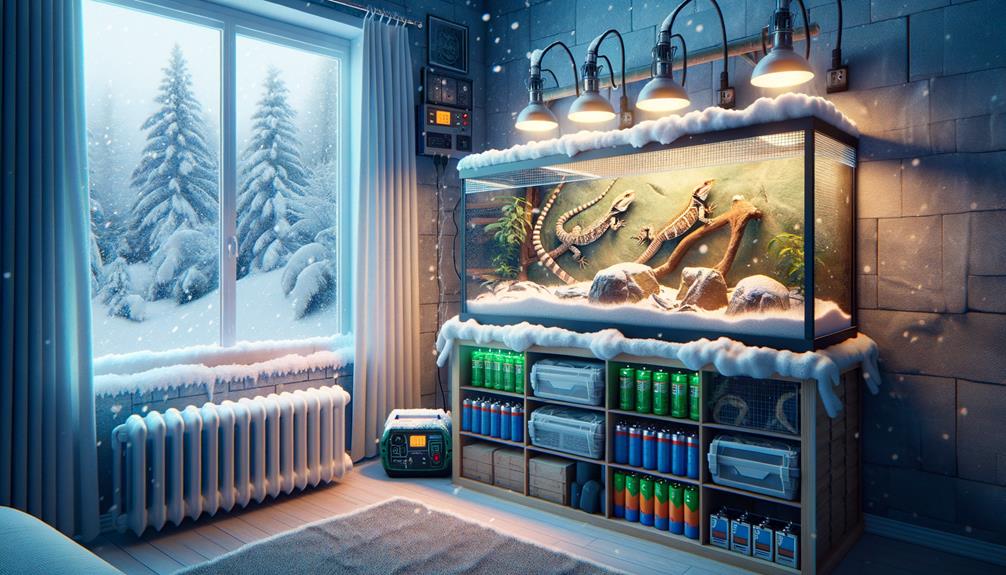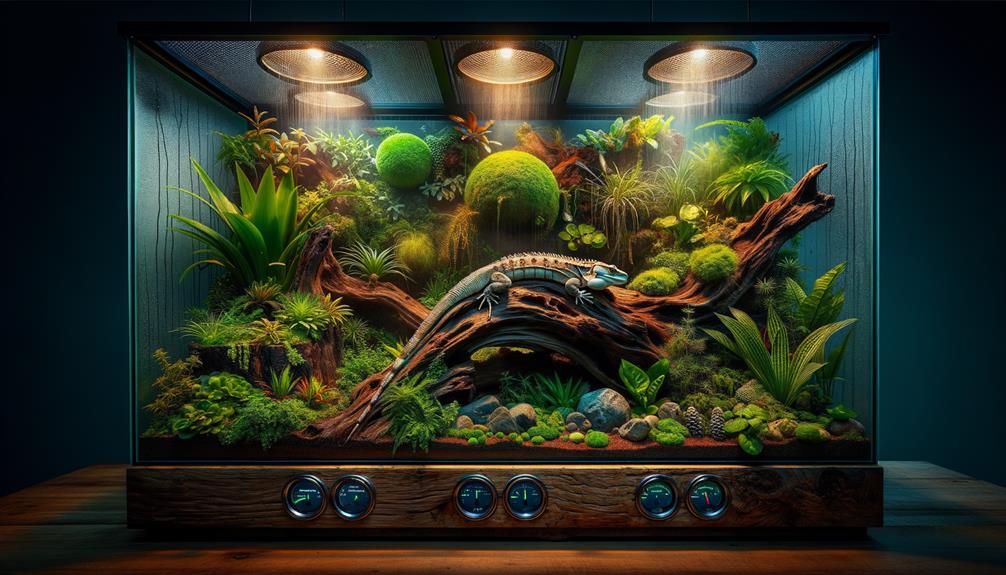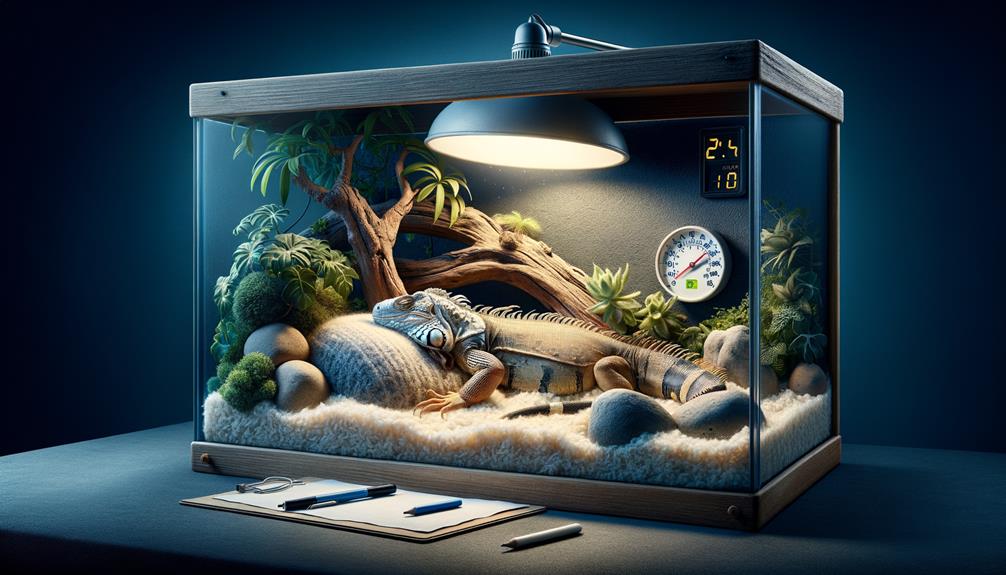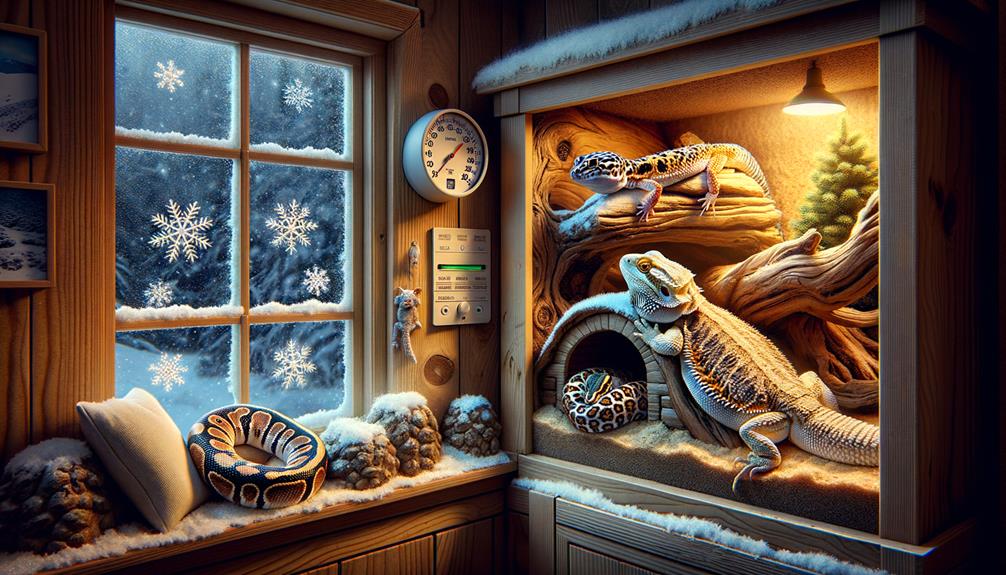When winter arrives, I adjust my reptiles' care to ensure they thrive. I fine-tune their heating and lighting to support proper digestion and metabolism. High-quality UV bulbs are crucial for vitamin D production and calcium absorption, preventing metabolic bone disease. To maintain optimal humidity, I use misting and soaking routines, and provide a humid hide with sphagnum moss. In case of power outages, I insulate their terrariums with styrofoam and have emergency heat sources on hand. Selecting the right bedding and monitoring shedding patterns are also vital for their comfort and health. Since each reptile species has unique needs, I make sure to research and consult with professionals to provide the best winter care.
Key Takeaways
Insulate terrariums with styrofoam and blankets to keep the heat in during the cold winter months.
Use high-quality UV bulbs to support your reptile's vitamin D production and calcium absorption.
Adjust humidity levels by misting and using a shallow bathing dish filled with sphagnum moss.
Have emergency heat sources, like battery-powered lamps, on hand in case of power outages.
Monitor and adjust habitat conditions to ensure your reptile sheds and hydrates properly.
Heating and Lighting Adjustments
When winter approaches, I make sure my reptiles receive the extra heat they need to support their digestion, immune function, and metabolism. In the wild, their natural habitats experience significant temperature drops during the colder months, which can negatively impact their health if not properly managed in captivity. Supplemental heat is crucial to maintaining their critical physiological functions.
Reptiles need UV light to produce vitamin D, which is necessary for calcium absorption. Without adequate UV light, they risk developing metabolic bone disease. I ensure their enclosures have high-quality UV bulbs and regularly monitor their output.
Proper humidity levels are also vital. Indoor heating can dry out the air during the colder months, leading to dehydration and shedding issues. I use hygrometers to monitor humidity and employ misting systems or water bowls to maintain the right levels, which helps keep their skin healthy and supports their hydration.
Preparing for Power Outages

Power outages can be a significant threat to reptile health, making it crucial to have a contingency plan in place. Glass terrariums, commonly used by reptile owners, lose heat rapidly when the power goes out, putting reptiles at risk. To mitigate this, I always keep materials like styrofoam and blankets on hand to insulate terrariums, which helps retain heat longer and provides a vital buffer during unexpected power failures.
In extreme cases, relocating reptiles to smaller enclosures can be a lifesaver. Smaller spaces are easier to heat and maintain temperature with limited resources. Once the power is restored, it's vital to gradually warm up reptiles to avoid thermal shock.
I've also invested in emergency heat sources, which have proven to be a game-changer. Battery-powered lamps and heating pads can provide necessary warmth when traditional heating elements are unavailable. These tools have been invaluable during outages, ensuring my reptiles remain safe and comfortable.
Maintaining Proper Humidity

Maintaining proper humidity levels in a reptile's environment is crucial for their hydration and successful shedding, especially during the dry winter months. If the humidity drops too low, dehydration and subsequent health issues, including improper shedding, can quickly follow. To prevent this, I ensure my reptile's habitat maintains ideal humidity by incorporating regular misting and soaking routines.
To manage humidity effectively, I combine misting with providing a shallow bathing dish filled with sphagnum moss or wet paper towels. This setup increases ambient moisture, helping to prevent dehydration and shedding issues.
Here's a quick reference table to maintain proper humidity:
| Method | Frequency |
|---|---|
| Misting | 2-3 times a day |
| Soaking | 2-3 times a week |
| Sphagnum Moss | Replace every 1-2 weeks |
| Humidity check | Daily |
| Hydration check | Weekly (visual inspection) |
Regular misting or soaking sessions are vital, especially during winter. These practices not only maintain hydration but also prevent illnesses linked to dry environments. Sphagnum moss is particularly effective as it retains moisture well, providing a humid microenvironment.
Bedding and Habitat Care

Selecting the right bedding is vital for different reptile species, as it directly impacts their comfort and hygiene in their habitat. Each species has unique needs, and the bedding plays a crucial role in maintaining their overall well-being. Proper habitat care requires attention to temperature and humidity levels, which can be influenced by the type of bedding used.
In my experience, Zilla's Bedding Guide has been a valuable resource. It helps identify the best bedding options tailored to specific species, ensuring ideal conditions. For example, some reptiles thrive on coconut fiber, which retains moisture well, helping to maintain appropriate humidity levels. This is particularly important during winter when indoor air tends to be dryer.
Providing a humid hide is another critical aspect of habitat care. It helps with proper shedding and promotes skin health by creating a microenvironment with higher humidity. Regular monitoring of shedding patterns is crucial, as any abnormalities could indicate the need for adjustments in bedding or other habitat conditions.
Additionally, ensuring the presence of adequate hiding spots is key to reducing stress and promoting natural behaviors. By paying close attention to these details and making informed choices, we can create a comfortable and healthy environment for our reptiles.
Choosing the Right Species

When choosing a reptile species for your home, research is key. You need to understand their specific care requirements, temperament, and lifespan to ensure you can meet their needs effectively. Different reptiles have unique needs, and understanding these is crucial for their welfare.
Consider the following factors:
- Habitat: Can you recreate the natural environment of your chosen reptile species, including the right size and type of enclosure?
- Heating and Lighting: Check the specific temperature and UVB lighting needs of your reptile.
- Humidity Needs: Species vary in their humidity requirements, with tropical reptiles needing higher humidity and desert species preferring dry conditions.
- Experience Level: Some species are better suited for beginners due to their hardiness and ease of care, while others require advanced knowledge and experience.
Consulting with professionals or veterinarians can provide valuable insights into the best reptile species for your lifestyle and experience level. They can help you understand the specific care requirements and ensure you're fully prepared. By doing your research, you'll be better equipped to provide a loving and healthy environment for your new reptile friend.
Frequently Asked Questions
What Temperature Is Too Cold for Reptiles?
I once had a bearded dragon named Spike, who became lethargic when the temperature dropped below 70°F. Reptiles need temperatures above 70°F to stay healthy, as it's essential for their digestion, metabolism, and immune system to function properly. If the temperature is too low, they can experience cold stress and related health issues.
How to Keep Reptiles Warm During Winter?
To keep reptiles warm during winter, I ensure their tanks have ceramic heat bulbs regulated by thermostats. I insulate their terrariums with styrofoam or blankets, and I regularly check the water temperatures in their aquatic habitats to prevent chilling.
Can Reptiles Adjust Their Body Temperature?
Reptiles can adjust their body temperature by moving to warmer or cooler areas. Since they're ectotherms, they rely on external heat sources, like basking under lamps, to regulate their internal temperature and maintain their bodily functions.
How Do I Control the Temperature in My Reptile Tank?
Controlling the temperature in your reptile tank isn't exactly brain surgery. You'll need a ceramic heat globe above the basking area to create a thermogradient, and a thermostat to keep things consistent.



